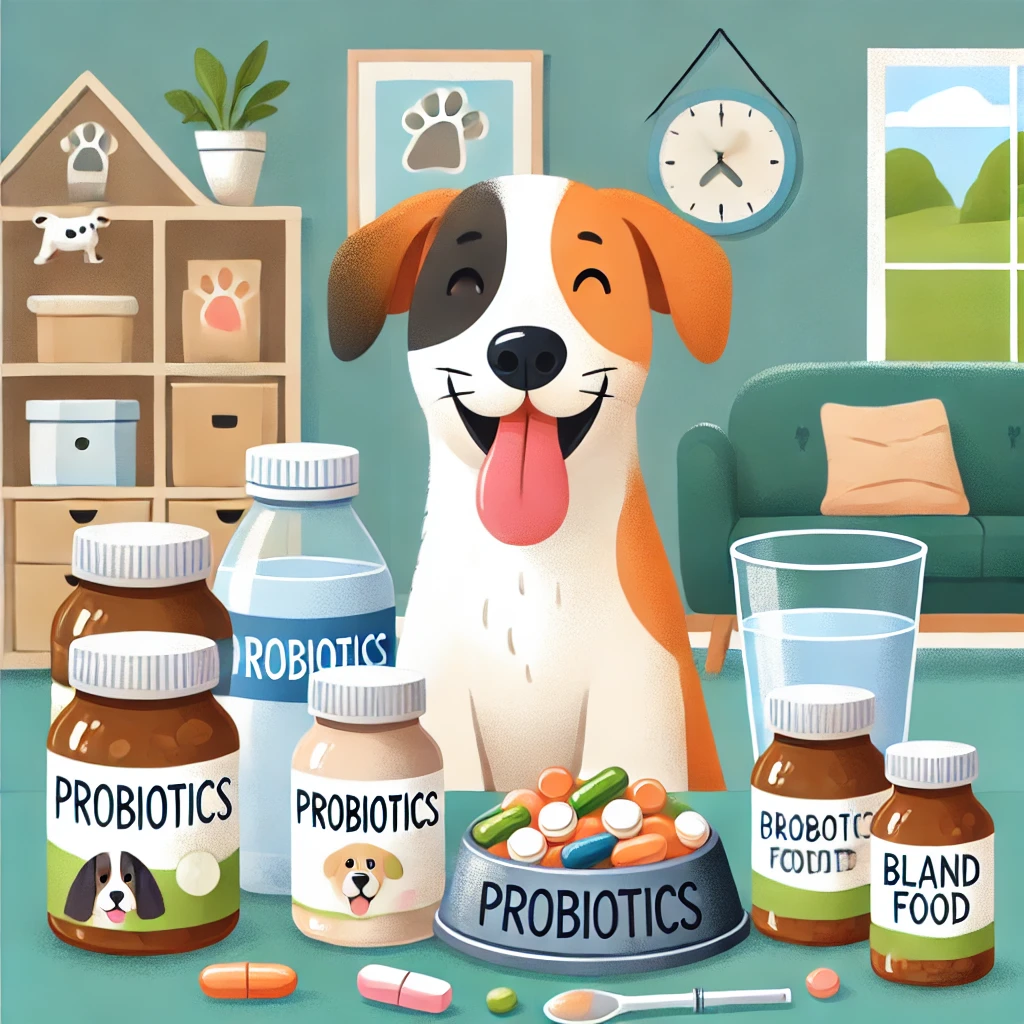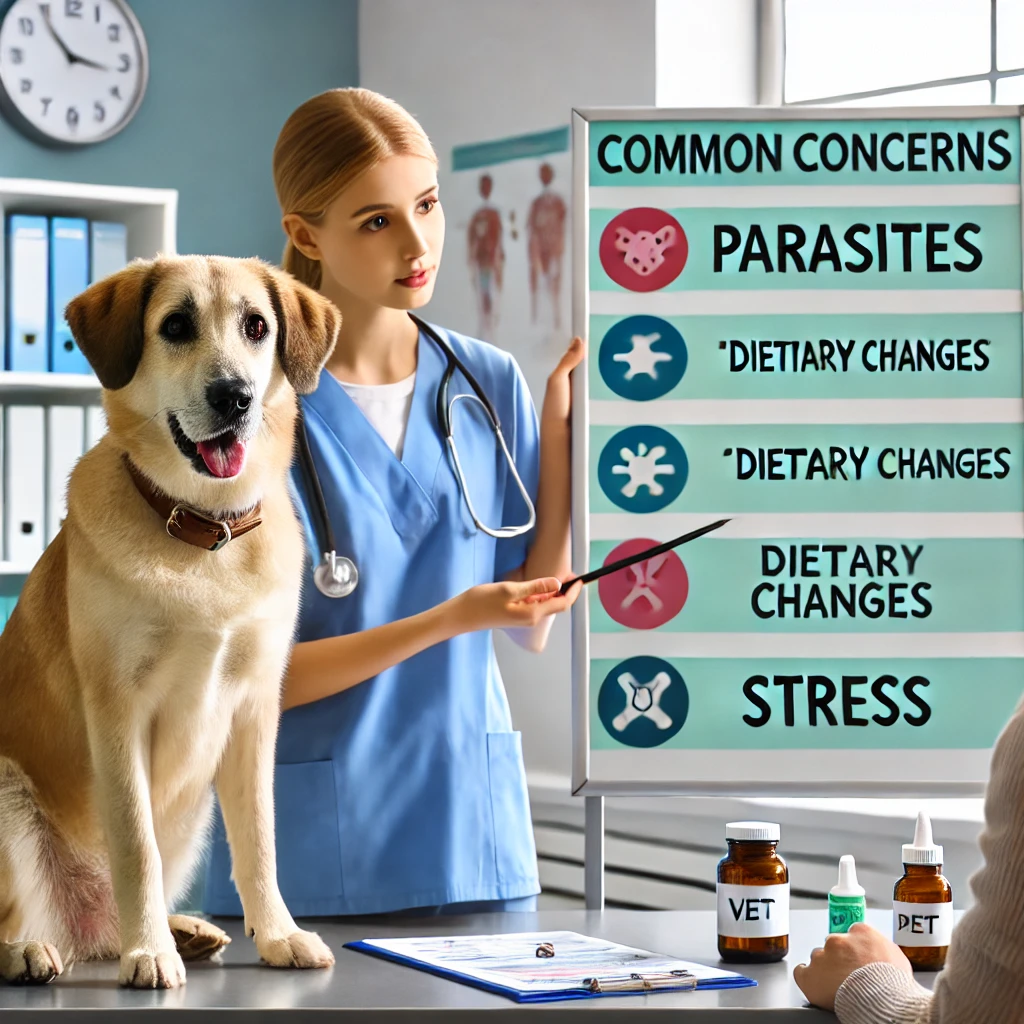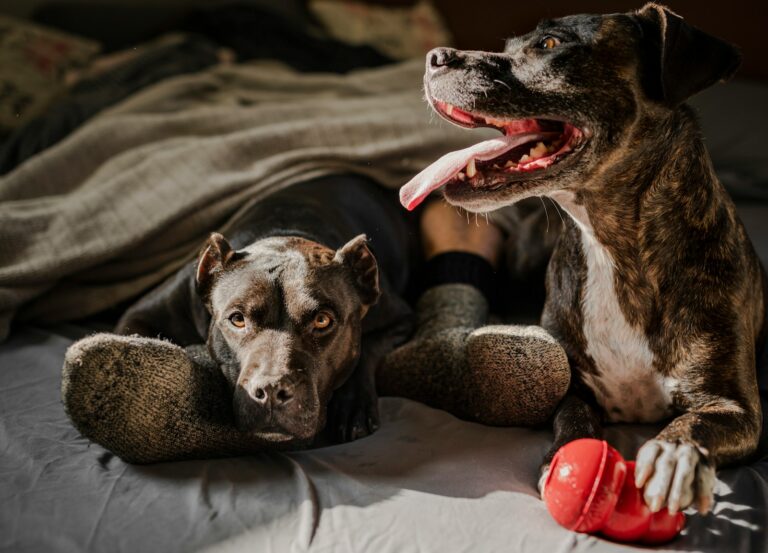
Discovering blood in dog stool can be alarming for any pet parent. It’s natural to feel anxious and concerned about your dog’s health when you notice such a symptom. While it may be a sign of something serious, there are many causes of blood in your dog’s stool—some are minor, while others may require immediate medical attention.
In this comprehensive guide, we’ll explore the potential causes of blood in dog stool, the symptoms to watch for, when to call the vet, and treatment options to help your furry friend recover. Knowing what to do when you spot blood in dog stool can make all the difference in keeping your dog healthy and happy.
Introduction
Your dog’s digestive system is a key part of their overall well-being, and their stool can be a clear indicator of their health. Changes in color, texture, or frequency often signal that something might be wrong. Finding blood in dog stool is a particularly worrisome sign, but it’s important not to panic.
This blog will break down the top causes of blood in dog stool, when to worry, and when to consult your veterinarian for professional advice. Whether it’s caused by something minor or indicative of a more serious condition, understanding the causes of blood in dog stool can help you take the right steps to protect your pet.
Symptoms to Watch For

When it comes to identifying blood in dog stool, there are a few types to be aware of. The color and consistency of the blood can provide clues about its cause and severity. Here are the different ways blood might present itself in your dog’s stool:
1. Hematochezia (Fresh, Red Blood)
- Appearance: Bright red blood mixed with the stool.
- Cause: This typically indicates bleeding in the lower digestive tract, such as the colon or rectum. It can be caused by inflammation, infection, or trauma.
- Should You Be Worried? Fresh blood is often less concerning than dark, tarry blood but still warrants a vet visit.
2. Melena (Dark, Tarry Stool)
- Appearance: Black, sticky, and tar-like stool.
- Cause: Melena typically indicates bleeding higher up in the digestive system, such as the stomach or small intestine. It can be caused by ulcers, tumors, or poisoning.
- Should You Be Worried? Yes. Melena is usually a sign of a more serious condition and should prompt a call to the vet immediately.
In addition to blood, there may be other symptoms accompanying blood in dog stool that can indicate a larger issue:
- Diarrhea: Frequent, loose stools, especially if accompanied by blood, are a clear sign something is wrong.
- Lethargy: A decrease in energy levels may indicate internal discomfort or illness.
- Vomiting: If your dog is vomiting in addition to passing blood, this may indicate poisoning, gastrointestinal infection, or a blockage.
- Loss of Appetite: If your dog refuses food, especially when combined with other symptoms, it could be a sign of a serious digestive problem.
- Abdominal Pain: Dogs in pain may whine, pant excessively, or avoid being touched.
If your dog exhibits any of these symptoms in addition to blood in dog stool, it’s time to call the vet.
Causes of Blood in Dog Stool

There are many reasons why your dog may have blood in their stool. Some causes are relatively benign, while others are more serious and require immediate attention. Below, we break down the most common causes of blood in dog stool:
1. Dietary Indiscretion (Eating Something They Shouldn’t)
Dogs are curious creatures, and sometimes they eat things they shouldn’t—whether it’s garbage, spoiled food, or a toy. When a dog ingests something inappropriate, it can irritate the digestive system, causing blood in dog stool.
- Symptoms: Diarrhea, vomiting, loss of appetite, blood in stool.
- Treatment: Typically, a vet will recommend withholding food for 12-24 hours to allow the digestive system to rest, followed by a bland diet (boiled chicken and rice). In some cases, medication may be prescribed to soothe the digestive tract.
2. Parasites
Intestinal parasites like hookworms, roundworms, and whipworms are common causes of blood in dog stool. These parasites attach themselves to the intestinal lining, leading to irritation and bleeding.
- Symptoms: Bloody stool, diarrhea, weight loss, bloating, lethargy.
- Treatment: Your vet will likely prescribe a deworming medication to eliminate the parasites. Regular fecal tests can help catch parasites early.
3. Infections (Bacterial or Viral)
Infections such as parvovirus, salmonella, or E. coli can cause severe gastrointestinal upset and blood in dog stool. Parvovirus, in particular, is highly contagious and can be deadly, especially in puppies.
- Symptoms: Diarrhea, vomiting, bloody stool, fever, lethargy.
- Treatment: Infections often require antibiotics or antiviral medications. In severe cases, hospitalization and IV fluids may be necessary.
4. Gastrointestinal Ulcers
Ulcers can develop in a dog’s stomach or intestines, often as a result of certain medications (such as NSAIDs), stress, or a pre-existing condition. These ulcers may lead to blood in dog stool, particularly dark, tarry blood (melena).
- Symptoms: Black, tarry stool, vomiting, abdominal pain, weight loss.
- Treatment: Your vet may prescribe antacids or proton pump inhibitors to reduce stomach acid and allow the ulcer to heal.
5. Colitis (Inflammation of the Colon)
Colitis is a condition that causes inflammation in the colon, often leading to diarrhea and blood in dog stool. It can be triggered by stress, infection, or food allergies.
- Symptoms: Diarrhea, bloody stool, mucus in stool, straining to defecate.
- Treatment: Colitis is typically treated with a bland diet, probiotics, and in some cases, anti-inflammatory medications.
6. Cancer (Gastrointestinal Tumors)
In rare cases, blood in a dog’s stool can be a sign of a more serious condition like cancer. Tumors in the digestive tract can cause both fresh blood and melena.
- Symptoms: Chronic bloody stool, weight loss, vomiting, abdominal pain, lethargy.
- Treatment: Treatment options may include surgery, chemotherapy, or radiation, depending on the type and stage of the cancer.
Should You Be Worried? A Guide for Pet Parents

Seeing blood in dog stool is concerning, but not every instance requires immediate panic. Here’s a guide to help you decide when to call the vet and when you might be able to monitor your dog at home.
When to Call the Vet:
- Bright Red Blood (Hematochezia): If the blood is fresh and red but your dog is otherwise acting normally (eating, playing, etc.), schedule a non-urgent vet visit. It could be something minor like a dietary upset or mild infection.
- Black, Tarry Stool (Melena): This is more serious. Melena indicates bleeding higher up in the digestive system and could be a sign of an ulcer, poisoning, or cancer. Call the vet immediately.
- Severe Diarrhea or Vomiting: If your dog is experiencing frequent diarrhea or vomiting, especially with blood, this could indicate a more severe infection or parasite.
- Other Concerning Symptoms: If your dog is lethargic, refusing food, or in visible discomfort, seek veterinary care.
When to Monitor:
- If your dog has blood in their stool but is otherwise acting normally and the blood is minimal, you can monitor them for 24 hours. Provide plenty of water and a bland diet (boiled chicken and rice) to allow their digestive system to recover.
- If the blood does not resolve within 24 hours or other symptoms develop, contact your vet.
Treatment Options

Treatment Options for Blood in Dog Stool
When it comes to treating blood in dog stool, the course of action depends entirely on the underlying cause. Once a vet has identified the reason for the bleeding, a treatment plan will be formulated to address the specific condition. Below is an in-depth exploration of the most common treatment options based on different diagnoses:
1. Dietary Management and Changes

For many dogs, blood in dog stool can result from gastrointestinal irritation, often caused by dietary indiscretion (eating something inappropriate) or food intolerance. In these cases, dietary changes are usually the first course of action to soothe the digestive system.
- Bland Diet:
- If your vet suspects that your dog’s bleeding is caused by mild irritation or a sensitive stomach, they may recommend a bland diet to allow the digestive system to heal. The most common bland diet consists of boiled chicken or turkey with plain white rice. This provides easily digestible proteins and carbohydrates without irritating the gastrointestinal tract.
- In some cases, pumpkin puree (plain, without added sugars or spices) can be added to the diet as it helps to firm up stool and regulate digestion.
- Hypoallergenic or Prescription Diets:
- For dogs with food allergies or sensitivities, your vet may recommend transitioning to a hypoallergenic or prescription diet. These diets are formulated to eliminate common allergens (such as chicken, beef, soy, or grains) and reduce inflammation in the gut.
- If your dog is suspected to have a food intolerance or inflammatory bowel disease (IBD), a hydrolyzed protein diet (where proteins are broken down into smaller molecules) may be prescribed to minimize the immune response in the digestive tract.
- Fiber Supplementation:
- In some cases of colitis (inflammation of the colon), adding a fiber supplement to the diet can help regulate bowel movements and promote healthy digestion. Fiber sources such as psyllium husk or pumpkin are often recommended to firm up loose stool and reduce bleeding.
2. Medications

Depending on the underlying cause of blood in dog stool, medications may be prescribed to address infections, inflammation, or other gastrointestinal issues. Common types of medications include:
- Antibiotics:
- If the bleeding is caused by a bacterial infection such as salmonella or E. coli, your vet will likely prescribe a course of antibiotics to eliminate the harmful bacteria in your dog’s gut. Common antibiotics include metronidazole, which also has anti-inflammatory properties, or amoxicillin for broader bacterial coverage.
- Probiotics may also be recommended in conjunction with antibiotics to restore the balance of good bacteria in the gut and promote healthier digestion.
- Deworming Medication:
- Intestinal parasites, such as hookworms, roundworms, and whipworms, are a frequent cause of blood in dog stool. Deworming medications like fenbendazole or pyrantel pamoate will be prescribed to eliminate these parasites.
- It’s important to complete the full course of deworming treatment, as some parasites require multiple rounds of medication to fully eradicate.
- Anti-inflammatory Medications:
- For dogs suffering from colitis or inflammatory bowel disease (IBD), anti-inflammatory medications may be prescribed to reduce swelling and irritation in the colon or intestines. Drugs like prednisone or budesonide are commonly used to reduce inflammation and help your dog recover from chronic gastrointestinal issues.
- In cases of gastritis (inflammation of the stomach lining), H2 blockers like famotidine (Pepcid) or proton pump inhibitors like omeprazole (Prilosec) can reduce stomach acid and prevent further damage to the digestive lining.
- Antidiarrheal Medications:
- If blood in dog stool is accompanied by severe diarrhea, your vet may prescribe antidiarrheal medications like loperamide (Imodium) to slow down bowel movements and allow for proper absorption of nutrients and water in the digestive tract. This can help firm up the stool and prevent further irritation and bleeding.
- Pain Relief:
- In cases where bleeding is associated with gastrointestinal ulcers or severe inflammation, your dog may be experiencing abdominal discomfort or pain. Pain relief medications such as buprenorphine or gabapentin may be prescribed to keep your dog comfortable while they recover.
- Non-steroidal anti-inflammatory drugs (NSAIDs) are generally avoided in cases of gastrointestinal bleeding, as they can exacerbate ulcers and damage to the digestive tract.
3. Fluid Therapy and Hydration Support

Dogs with blood in their stool, especially those experiencing diarrhea or vomiting, are at risk of dehydration. Maintaining hydration is a critical part of treatment, especially if the dog is losing fluids rapidly through loose stools or frequent vomiting.
- IV Fluids:
- If your dog is severely dehydrated or unable to keep down water, they may require intravenous (IV) fluids to restore hydration and balance electrolytes. IV fluids help rehydrate your dog quickly, especially in cases of severe diarrhea, vomiting, or systemic infection.
- Subcutaneous Fluids:
- For dogs with mild dehydration, subcutaneous fluids (fluids injected just under the skin) may be administered by your vet to provide rehydration over a period of several hours. This option is less invasive than IV fluids and can sometimes be done on an outpatient basis.
4. Surgery
In cases where blood in dog stool is caused by a more serious condition like a gastrointestinal obstruction, tumor, or severe trauma to the intestines, surgery may be required.
- Foreign Object Removal:
- If your dog has ingested a foreign object (such as a toy, bone fragment, or cloth) that has caused a blockage in the digestive tract, surgery may be needed to remove it. Blockages can cause inflammation, bleeding, and severe digestive distress, and immediate intervention is required to prevent life-threatening complications.
- Tumor Resection:
- For dogs diagnosed with gastrointestinal tumors, surgery may be necessary to remove the tumor and prevent further bleeding or obstruction. Depending on the location and type of tumor, your vet may recommend additional treatments such as chemotherapy or radiation.
5. Probiotics and Gut Health Support
Maintaining a healthy gut microbiome is essential for digestive health, especially in cases where your dog has experienced inflammation, infection, or long-term gastrointestinal issues. Probiotics can play a significant role in restoring balance to the digestive system after a bout of blood in dog stool.
- Probiotics:
- Probiotics, such as FortiFlora or Proviable, contain beneficial bacteria that help support healthy digestion and reduce inflammation in the gut. These supplements are often recommended after a course of antibiotics to replenish the “good” bacteria that may have been lost during treatment.
- Prebiotics:
- Prebiotics, which are non-digestible fibers that promote the growth of healthy bacteria, may also be included in your dog’s diet. This can improve gut health and reduce the risk of future digestive issues that could lead to blood in dog stool.
6. Addressing Underlying Health Conditions
In cases where blood in dog stool is caused by a chronic or systemic health condition, such as inflammatory bowel disease (IBD), pancreatitis, or kidney disease, managing the underlying condition is key to reducing symptoms and preventing further gastrointestinal distress.
- Long-term management:
- Chronic conditions like IBD may require long-term medication, regular vet check-ups, and a carefully controlled diet to keep symptoms at bay and prevent future episodes of blood in dog stool.
- Dogs with systemic conditions, such as kidney disease, may need specialized diets that are low in protein or phosphorus to reduce the strain on their kidneys and prevent digestive upsets that could lead to bleeding.
Monitoring and Follow-up Care
Regardless of the treatment plan, monitoring your dog closely after any episode of blood in dog stool is essential. Regular follow-up visits with your veterinarian will help ensure that the treatment is working and that your dog is on the road to recovery.
- Stool monitoring:
- Keep an eye on your dog’s stool consistency, color, and frequency. Any recurrence of blood or worsening symptoms should be reported to your vet immediately.
- Hydration:
- Ensure your dog is drinking plenty of water and staying hydrated, particularly if they experienced diarrhea or vomiting during their illness.
- Diet consistency:
- Stick to the recommended diet provided by your vet, and avoid making sudden changes to your dog’s food that could further irritate their digestive system.
- Regular vet check-ups:
- For chronic conditions or long-term recovery, regular vet visits are important to monitor your dog’s progress and make any necessary adjustments to their treatment plan.
In a Nut shell

The treatment options for blood in dog stool range from simple dietary adjustments to more intensive medical interventions, depending on the root cause of the bleeding. By working closely with your veterinarian and following the prescribed treatment plan, most dogs recover successfully from gastrointestinal issues. Always monitor your dog closely, follow up with regular vet visits, and provide the appropriate care to keep your furry friend healthy and happy.
Vet-Approved Answers to Common Questions
Can stress cause blood in dog stool?
Yes, stress can lead to colitis, which may cause blood in dog stool. This is particularly common in dogs who have experienced recent changes such as moving, travel, or a new household member.
Can switching dog food cause blood in stool?
Sudden changes in diet can upset your dog’s stomach and lead to diarrhea, which may sometimes contain blood. To avoid this, gradually transition to new food over the course of a week.
Should I take my dog to the vet immediately if I see blood in their stool?
If your dog is otherwise acting normal and the blood is minimal, you can monitor them for 24 hours. However, if the blood Should I Take My Dog to the Vet Immediately if I See Blood in Their Stool?
The sight of blood in dog stool can be alarming, and the natural reaction is to want immediate answers. However, whether you need to rush to the vet depends on several factors, including the amount and appearance of the blood, your dog’s overall behavior, and the presence of additional symptoms.
Here’s a more detailed breakdown of what to do based on the situation:
1. Fresh, Bright Red Blood (Hematochezia)
- When to Monitor at Home:
- If you notice a small amount of bright red blood in your dog’s stool but your dog is otherwise acting normally—eating, drinking, playing, and behaving as usual—it may not require an emergency visit. Fresh red blood typically indicates bleeding from the lower part of the digestive tract, such as the colon or rectum, which can result from minor irritations like dietary indiscretion or constipation. In these cases, you can monitor your dog at home for 24-48 hours.
- During this time, switch your dog to a bland diet of boiled chicken or turkey with rice, and ensure they are staying hydrated. Avoid giving any treats, bones, or fatty foods that could further upset their digestive system.
- When to Call the Vet:
- If the blood persists for more than 24 hours, increases in volume, or if your dog starts showing additional symptoms like diarrhea, vomiting, or lethargy, it’s time to consult your vet. Prolonged or worsening signs could indicate a more serious issue such as an infection, parasites, or colitis.
2. Black, Tarry Stool (Melena)
- When to Call the Vet Immediately:
- Melena, which appears as black, sticky, and tarry stool, is a sign of internal bleeding higher up in the digestive system (such as the stomach or small intestine). This could be due to a variety of serious conditions, such as ulcers, cancer, or poisoning (e.g., from ingesting toxins like rat poison or certain medications such as NSAIDs).
- If you notice this type of stool, you should contact your veterinarian immediately, as it may indicate a more severe underlying issue. Waiting too long in these cases can lead to further complications, including dehydration, shock, or severe blood loss.
3. Large Quantities of Blood or Frequent Occurrences
- When to Visit the Vet Urgently:
- If you notice a large amount of blood in your dog’s stool, regardless of whether it’s bright red or dark, you should seek veterinary care right away. Large quantities of blood can quickly lead to anemia, dehydration, and other serious complications, especially if accompanied by frequent diarrhea or vomiting.
- Additionally, if you notice blood in dog stool that occurs frequently over the course of a day or more, this could signal an ongoing issue, such as a severe infection, parasites, or gastrointestinal disease, all of which require veterinary treatment.
4. Accompanying Symptoms (Vomiting, Lethargy, or Loss of Appetite)
- When to Visit the Vet:
- If your dog is showing additional signs of illness—such as vomiting, lethargy, a loss of appetite, or visible discomfort in their abdomen—this is a red flag that something more serious may be occurring. The combination of these symptoms along with blood in dog stool could point to a more significant issue like pancreatitis, gastrointestinal obstructions, or even parvovirus (in puppies or unvaccinated dogs).
- It’s important to consult your veterinarian as soon as possible to rule out these more severe conditions and to initiate treatment if necessary.
5. Recent Changes in Diet or Routine
- When to Monitor:
- If you recently switched your dog’s food, or if your dog has been under stress due to changes such as a move or the introduction of a new pet, it’s possible that the blood in the stool is related to an upset digestive system or mild colitis (inflammation of the colon). In this case, you can monitor your dog’s symptoms for 24-48 hours.
- If the blood in the stool resolves on its own, your dog may just be adjusting to the changes. However, if the blood persists or worsens, it’s best to check with your vet to make sure there isn’t an underlying issue.
6. Puppies and Senior Dogs
- When to Visit the Vet:
- Puppies and senior dogs are more vulnerable to gastrointestinal issues, and their immune systems may not be as robust as adult dogs in their prime. In puppies, blood in the stool can be a sign of dangerous infections like parvovirus, which can be fatal if not treated promptly. Senior dogs, on the other hand, may have underlying conditions such as cancer, ulcers, or severe dental disease that could lead to blood in the stool.
- If your puppy or senior dog has blood in their stool, it’s always best to err on the side of caution and contact your vet for an evaluation, even if the amount of blood seems minor.
7. After Medication or Surgery
- When to Contact the Vet:
- If your dog has recently been prescribed medications (such as NSAIDs for pain or steroids for inflammation) or has undergone surgery, the presence of blood in dog stool could be a side effect or complication. NSAIDs, for example, can cause stomach ulcers or gastrointestinal irritation that leads to blood in the stool.
- In these cases, contact your vet immediately to discuss your dog’s symptoms and determine whether the medication should be adjusted or discontinued.
Conclusion
The presence of blood in dog stool is always a reason for concern, but not every instance requires an emergency vet visit. By carefully assessing your dog’s symptoms, the appearance of the blood, and their overall behavior, you can determine whether monitoring or immediate veterinary attention is necessary.
If you’re ever in doubt, it’s always best to consult your veterinarian for guidance. Early intervention and appropriate treatment can make all the difference in helping your dog recover from whatever is causing their gastrointestinal upset. Whether it’s something as simple as dietary indiscretion or a more serious condition like an infection or cancer, being proactive and informed will ensure your dog gets the care they need.
Related Articles:
Can Dogs Drink Milk Safely? Here’s What Vets Have to Say
Dog Treadmill vs. Outdoor Walks: Which Is Better for Your Pup?


